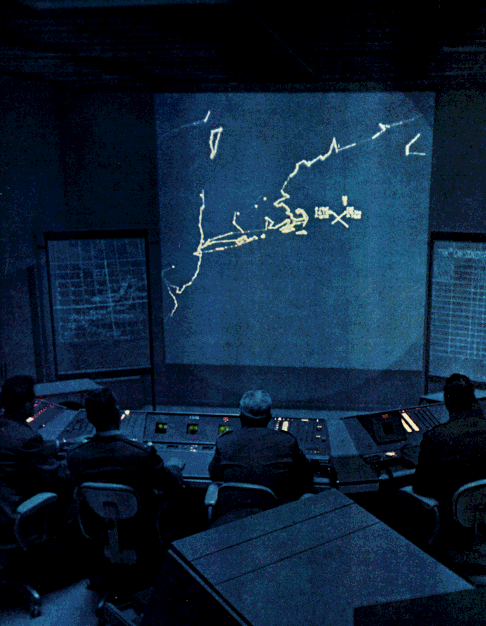Photographic Display Unit on:
[Wikipedia]
[Google]
[Amazon]
 The Photographic Display Unit, or PDU, was a large-format display system used by the
The Photographic Display Unit, or PDU, was a large-format display system used by the
 The Photographic Display Unit, or PDU, was a large-format display system used by the
The Photographic Display Unit, or PDU, was a large-format display system used by the Royal Air Force
The Royal Air Force (RAF) is the United Kingdom's air and space force. It was formed towards the end of the First World War on 1 April 1918, becoming the first independent air force in the world, by regrouping the Royal Flying Corps (RFC) an ...
to present radar
Radar is a detection system that uses radio waves to determine the distance ('' ranging''), angle, and radial velocity of objects relative to the site. It can be used to detect aircraft, ships, spacecraft, guided missiles, motor vehicles, w ...
images for interpretation by a number of operators and commanders. Made by Kelvin Hughes
Hensoldt UK, formerly Kelvin Hughes, is a British company specialising in the design and manufacture of navigation and surveillance systems and a supplier of navigational data to both the commercial marine and government marketplace.
The company ...
, it projected a diameter image that could optionally be overlaid with a map and range rings. The PDU was originally designed for the ROTOR
Rotor may refer to:
Science and technology
Engineering
*Rotor (electric), the non-stationary part of an alternator or electric motor, operating with a stationary element so called the stator
*Helicopter rotor, the rotary wing(s) of a rotorcraft ...
system and subsequent AMES Type 80-based Master Radar Stations. A smaller version with a display was used onboard Royal Navy
The Royal Navy (RN) is the United Kingdom's naval warfare force. Although warships were used by Kingdom of England, English and Kingdom of Scotland, Scottish kings from the early medieval period, the first major maritime engagements were foug ...
ships, and a larger version projected onto movie screen
A projection screen is an installation consisting of a surface and a support structure used for displaying a projected image for the view of an audience. Projection screens may be permanently installed, as in a movie theater; painted on the w ...
s was used in the SAGE system in the US.
Description
The PDU was essentially an automated 35mm film processing system. A bright cathode ray tube duplicated the image from one of the radar consoles, while the film was exposed in front of it through an f2 lens. Each complete scanning rotation of the radar took 15 seconds, but as it reached a selected location, normally opposite the direction the radar was designed to observe, the film was pulled out from in front of the lens and a new frame pulled into place. The recently exposed frame then moved through four stations, moving through one every 15 seconds. The first sprayed it with a developer, the next with water, then a fixer, water again, and then it was dried with an air blower. The entire developing process took one minute, after which the frame was pulled into a large film projector that shone upwards into the bottom of the plotting table. Plotters viewing the table from the top used methods developed inWorld War I
World War I (28 July 1914 11 November 1918), often abbreviated as WWI, was List of wars and anthropogenic disasters by death toll, one of the deadliest global conflicts in history. Belligerents included much of Europe, the Russian Empire, ...
to maintain tracks for the various aircraft. As each new frame appeared, they would place small arrow-shaped markers on the new location, leaving behind the ones they had placed earlier. This produced a trail that indicated the direction of travel. The plotting table was normally covered with a large sheet of semi-transparent paper that contained a National Grid map and allowed the operators to make notes directly on its surface.
Each PDU was fed from a reel of film. Two machines were used at each site. When the film or developer system ran low or there was any sort of problem, the operator could switch to the second unit simply by moving a mirror under the projector. The used reel could then be removed and used as a record of action.
The Navy version differed only in size, using 16mm film
16 mm film is a historically popular and economical gauge of film. 16 mm refers to the width of the film (about inch); other common film gauges include 8 and 35 mm. It is generally used for non-theatrical (e.g., industrial, ed ...
and being generally smaller.
The US SAGE system used the PDU hardware to project an even larger display onto a movie screen, which was used for overall battle control in the "subsector command post", more widely known as the "blue room". In these systems the original CRT was replaced with a charactron driven by the FSQ-7
The AN/FSQ-7 Combat Direction Central, referred to as the Q7 for short, was a computerized command and control system for Cold War ground-controlled interception used in the USAF Semi-Automatic Ground Environment (SAGE) air defense network.
Th ...
computer, outputting both graphics and character data onto the film.
References
Citations
Bibliography
* {{cite web , url=http://www.ventnorradar.co.uk/PDU.htm , title=The Kelvin-Hughes Photographic Display Unit (PDU) , website=Ventnor Radar , access-date=21 May 2017 , date=2006 , first=D.C. , last=Adams Radar signal processing Cold War military equipment of the United Kingdom Royal Air Force Royal Navy